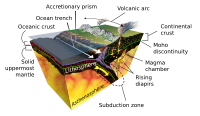
Photo from wikipedia
Flat or near-horizontal subduction of oceanic lithosphere has been an important tectonic process both currently and in the geologic past. Subduction of the aseismic Nazca Ridge beneath South America has… Click to show full abstract
Flat or near-horizontal subduction of oceanic lithosphere has been an important tectonic process both currently and in the geologic past. Subduction of the aseismic Nazca Ridge beneath South America has been associated with the onset of flat subduction and the termination of arc volcanism in Peru, making it an ideal place to study flat-slab subduction. Recently acquired seismic recordings for 144 broadband seismic stations in Peru permit us to image the Mohorovičić discontinuity (Moho) of the subducted oceanic Nazca plate, Nazca Ridge, and the overlying continental Moho of the South American crust in detail through the calculation of receiver functions. We find that the subducted over-thickened ridge crust is likely significantly eclogitized ~350 km from the trench, requiring that the inboard continuation of the flat slab be supported by mechanisms other than low-density crustal material. This continuation coincides with a low-velocity anomaly identified in prior tomography studies of the region immediately below the flat slab, and this anomaly may provide some support for the flat slab. The subduction of the Nazca Ridge has displaced most, if not the entire South American lithospheric mantle beneath the high Andes as well as up to 10 km of the lowermost continental crust. The lack of deep upper-plate seismicity suggests that the Andean crust has remained warm during flat subduction and is deforming ductilely around the subducted ridge. This deformation shows significant coupling between the subducting Nazca oceanic plate and overriding South American continental plate up to ~500 km from the trench. These results provide important modern constraints for interpreting the geological consequences of past and present flat-slab subduction locations globally.
Journal Title: Geosphere
Year Published: 2017
Link to full text (if available)
Share on Social Media: Sign Up to like & get
recommendations!